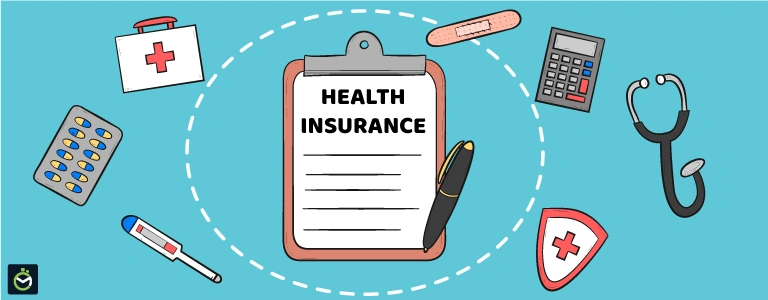Health insurance policies are legally binding contracts between an individual or group and an insurance company. In exchange for a monthly fee (the premium), the insurer agrees to pay a portion of the insured’s medical expenses for covered services, helping to protect against high medical costs.
Health insurance has become one of the most important financial safety nets in today’s world. With medical expenses skyrocketing, even a simple hospital stay can leave a deep hole in your pocket. Imagine a sudden illness or an unexpected surgery without insurance; you might have to dip into your savings or borrow money. That’s where health insurance comes in. It provides financial support by covering medical bills, hospitalization expenses, and pre- and post-hospitalization costs, depending on your policy.
In simple terms, health insurance is like a contract between you and the insurance provider. You pay a regular premium, and in return, the insurer promises to cover your medical expenses according to the policy’s terms. It acts as a financial cushion during medical emergencies, ensuring that money doesn’t come in the way of your health. Unlike life insurance, which provides a payout to your family after death, health insurance works while you’re alive, helping you manage medical costs effectively.
Why is it so essential today? Because healthcare costs are rising faster than inflation. A surgery that cost $1,000 a decade ago could easily cost $5,000–$10,000 today. Without health insurance, many families are forced into debt or have to compromise on the quality of healthcare. With the right policy, you don’t just save money, you gain peace of mind knowing that your health and finances are protected.
How Health Insurance Works
- Premium: The regular payment you make to the insurer to keep your coverage active.
- Deductible: The amount you must pay for covered healthcare services out-of-pocket before your insurance begins to pay.
- Copayment (Copay): A fixed amount you pay for a specific covered service, such as a doctor’s visit or prescription drug, often at the time you receive the service.
- Coinsurance: Your share of the costs for a covered service, calculated as a percentage of the allowed amount, after you have met your deductible.
- Out-of-Pocket Maximum: The maximum amount you will have to pay for covered services during a policy period, after which the plan will pay 100% of covered expenses.
- In-Network Providers: Doctors, hospitals, and other providers that have a contract with your insurance plan to offer services at a negotiated, lower rate.
- Out-of-Network Providers: Providers without a contract with your plan. Visiting these providers typically results in higher costs for you.
Types of health insurance plans
- Health Maintenance Organization (HMO): You choose a primary care physician (PCP) who coordinates all of your care and provides referrals to specialists. Care is typically only covered if you use providers within the plan’s network.
- Preferred Provider Organization (PPO): You have more flexibility to see any doctor or specialist without a referral, and you can see out-of-network providers for a higher fee. Premiums are generally higher than for HMOs.
- Exclusive Provider Organization (EPO): You are required to use doctors and hospitals within the network (except in emergencies), but unlike an HMO, you do not need a referral to see a specialist.
- Point-of-Service (POS) Plan: Combines features of HMOs and PPOs. You typically choose a PCP for coordinated care, but can go out-of-network for a higher cost.
- High-Deductible Health Plan (HDHP): Offers lower monthly premiums but requires you to pay more out-of-pocket before coverage starts. These are often combined with Health Savings Accounts (HSAs) for tax-advantaged savings.
- Catastrophic Plan: A type of HDHP with a very high deductible, intended primarily for young, healthy people in case of a major medical emergency.
How to Get Health Insurance
- Employer-Sponsored Plans: Many people receive coverage through their own or a family member’s employer.
- Marketplace Plans: Individual and family plans are available through federal or state marketplaces under the Affordable Care Act (ACA).
- Government Programs: Programs like Medicare (for those 65 or older or with specific disabilities) and Medicaid (for low-income individuals and families) are available based on eligibility.
- Direct from an Insurer: You can purchase a plan directly from a private insurance company.
Different Types of Health Insurance Policies

Health insurance isn’t a one-size-fits-all solution. Different people have different needs, and insurance companies have designed various plans to cater to them. Let’s break down the major types of health insurance policies:
Individual Health Insurance Plans
As the name suggests, this type of policy covers only one person. The sum insured is dedicated entirely to the insured individual. For example, if you buy a policy with coverage of $100,000, that entire amount is available for your treatment. This is a great option for single individuals or people who want separate coverage for each family member.
Family Floater Policies
Family floater policies are designed for families. Instead of buying separate policies for each member, you can buy one policy that covers the entire family. The sum insured is shared among all members. For instance, if the policy covers $200,000 and two family members are hospitalized, both can claim within that limit. This type of policy is usually more affordable compared to buying multiple individual policies.
Group Health Insurance Plans
These are typically provided by employers to their employees. The premiums are often lower, and coverage may include the employee’s family as well. The downside, however, is that you’re covered only as long as you’re employed with that company. Once you leave the job, you lose the coverage.
Critical Illness Insurance
This type of policy covers life-threatening diseases such as cancer, stroke, kidney failure, or heart attack. Unlike standard health insurance, which pays hospital bills, critical illness insurance provides a lump sum amount upon diagnosis. This money can be used not just for treatment but also for other financial needs during recovery.
Top-up and Super Top-up Plans
These policies come into play when your existing health insurance coverage isn’t enough. For example, if you have a policy covering $100,000 but your hospital bill is $150,000, a top-up plan can cover the extra amount. A super top-up goes a step further by covering multiple claims in a year once the threshold is crossed.
Health Insurance Policies

When comparing different health insurance plans, you’ll notice several common features. These are the benefits and facilities that make health insurance more valuable:
Coverage and Sum Insured
This is the most important aspect. The sum insured is the maximum amount the insurance company will pay in case of hospitalization. It’s important to choose an adequate sum insured, keeping in mind rising medical costs and family needs. For a family, higher coverage is usually advisable.
Cashless Treatment Facility
Most insurers have tie-ups with network hospitals where you can avail of cashless treatment. This means you don’t have to pay upfront at the hospital; the insurance company settles the bill directly with the hospital. It saves you from arranging large sums of money in emergencies.
Pre and Post-Hospitalization Benefits
Good health insurance policies cover not just the hospital stay but also expenses incurred before and after hospitalization. This could include diagnostic tests, medicines, and follow-up visits. Typically, pre-hospitalization expenses up to 30 days and post-hospitalization up to 60–90 days are covered.
Daycare Procedures
Not all treatments require a full day’s stay in the hospital. With modern technology, many surgeries and treatments are completed in a few hours. Policies now cover such daycare procedures as well, which is a big advantage.
Benefits of Having Health Insurance

The benefits of health insurance go beyond just paying hospital bills. Let’s look at the major advantages:
Financial Protection Against Medical Emergencies
The biggest advantage is financial security. Health insurance protects you from draining your savings in case of medical emergencies. A good policy ensures that you can access quality healthcare without worrying about the costs.
Tax Benefits under Health Insurance
In many countries, including the U.S. and India, health insurance premiums qualify for tax deductions. For instance, under Section 80D of the Income Tax Act in India, you can claim deductions on the premiums paid for yourself and your family. This makes health insurance not just a health safeguard but also a tax-saving tool.
Access to Quality Healthcare
With health insurance, you don’t have to compromise on treatment. Whether it’s choosing a reputable hospital, consulting a specialist, or undergoing advanced procedures, your policy gives you access to better healthcare options.
Factors to Consider Before Buying a Health Insurance Policy
Buying health insurance is a long-term decision. Before finalizing a plan, you need to look beyond just the premium cost. Here are the key factors to consider:
Age and Health Condition
Your age and current health status directly impact the premium and coverage. Younger people usually pay lower premiums. If you have pre-existing conditions, some policies may exclude them or impose waiting periods.
Premium and Affordability
While you should aim for higher coverage, the premium must fit your budget. Compare policies carefully to balance affordability with benefits. Don’t fall for the cheapest option; it may not provide adequate coverage when you need it most.
Network Hospitals and Claim Settlement Ratio
Always check the insurer’s network of hospitals. A wide network ensures you can access cashless treatment anywhere. Also, the claim settlement ratio (CSR) is important, as it shows the percentage of claims settled by the company. A higher CSR indicates reliability.
Waiting Period and Exclusions
Almost all policies come with waiting periods for pre-existing diseases. This can range from 2 to 4 years. Some treatments, like maternity benefits, also have waiting periods. Be aware of what’s excluded from coverage so you don’t face surprises during emergencies.
How to Choose the Best Health Insurance Policy

Choosing the best health insurance policy can feel overwhelming because of the wide range of options available in the market. Each insurer offers different benefits, features, and terms, making it crucial to understand what truly matters before signing up. Instead of rushing into a decision, it’s best to take a step-by-step approach.
Assess Your Needs First
The first thing you should do is analyze your requirements. Are you single, married, or have a family to cover? Do you need coverage only for hospitalization, or are you looking for critical illness coverage as well? For instance, a young individual might be fine with a basic individual plan, while someone with a spouse and children should consider a family floater. For people with a history of certain illnesses in the family, adding a critical illness rider could be a smart move.
Compare Policies Online
With digital platforms, comparing policies has become easier than ever. Instead of relying on an agent’s advice alone, you can use online comparison websites to check premiums, coverage, features, and claim settlement ratios. This allows you to make an informed choice and avoid falling for flashy marketing tactics.
Look Beyond Premiums
One of the biggest mistakes people make is choosing a policy based only on low premiums. While affordability is important, a cheap policy may not provide sufficient coverage or may have too many exclusions. It’s better to pay slightly more for comprehensive coverage than to be left uncovered during emergencies.
Check Hospital Network
A policy with a wide network of hospitals ensures that you can get cashless treatment easily. Imagine falling sick while traveling to another city. If your insurer has tie-ups nationwide, you can still receive cashless treatment without any stress.
Sub-Limits and Co-Payment Clauses
Some policies impose sub-limits on room rent, surgery costs, or even doctors’ fees. Others may have a co-payment clause, which means you’ll need to share a part of the bill. Reading the fine print helps you avoid nasty surprises later.
Latest Trends in the Health Insurance Industry

The health insurance industry is evolving rapidly, driven by technology, lifestyle changes, and customer expectations. Here are some of the latest trends shaping the future of health insurance:
Digitalization and Online Services
From buying policies to filing claims, everything is moving online. Insurers now provide apps and online portals for customers to manage their policies easily. Telemedicine services are also being bundled with health insurance plans.
Customizable Policies
Instead of one-size-fits-all, insurers are offering modular policies where you can pick and choose add-ons according to your needs. For instance, you can add maternity benefits, wellness programs, or critical illness riders to your base policy.
Wellness and Preventive Care
Health insurance is no longer limited to hospitalization. Many insurers are rewarding customers for staying healthy. This includes discounts for regular health check-ups, gym memberships, or even tracking fitness through wearable devices.
Cashless Everywhere
Cashless treatment is expanding beyond network hospitals. Some insurers are now offering “cashless everywhere” features where you can avail cashless treatment even in non-network hospitals, subject to conditions.
AI and Data Analytics
Insurance companies are using AI and big data to analyze health risks, predict illnesses, and offer personalized premium plans. This ensures fairer pricing and quicker claim settlements.
Role of Government Health Insurance Schemes

Apart from private insurers, many governments across the world have launched public health insurance schemes to make healthcare accessible and affordable for everyone, especially low-income families.
Public Schemes in India
For example, in India, the Ayushman Bharat – Pradhan Mantri Jan Arogya Yojana (PM-JAY) provides free health coverage to millions of economically weaker families. It offers coverage of up to ₹5 lakh per family per year for secondary and tertiary care hospitalization.
Medicare and Medicaid in the U.S.
In the United States, Medicare covers senior citizens aged 65 and above, while Medicaid provides insurance for low-income families and individuals. These schemes ensure that essential healthcare isn’t out of reach for vulnerable populations.
Universal Healthcare in Europe
Many European countries, like the UK with its NHS (National Health Service), provide universal healthcare coverage. While funded by taxes, these systems ensure that healthcare is accessible to all citizens without direct costs at the point of use.
Why Government Schemes Matter
Government schemes bridge the gap for people who cannot afford private health insurance. They also reduce the financial burden of healthcare on families and improve access to essential medical facilities.
Steps to File a Health Insurance Claim

Filing a health insurance claim might seem complicated, but knowing the steps can make the process smoother. There are generally two types of claims: cashless and reimbursement.
Cashless Claim Process
-
Get admitted to a network hospital.
-
Show your health insurance card at the hospital’s insurance desk.
-
The hospital sends a pre-authorization request to your insurer.
-
Once approved, you can avail treatment without paying upfront.
-
The insurer settles the bill directly with the hospital.
Reimbursement Claim Process
-
Get admitted to any hospital, even if it’s not in the insurer’s network.
-
Pay the bills upfront during discharge.
-
Collect all documents, including discharge summary, bills, and reports.
-
Submit the documents to your insurance company.
-
Once verified, the insurer reimburses the expenses to your account.
Tips for Smooth Claim Settlement
-
Always inform your insurer immediately when hospitalized.
-
Keep copies of all medical documents.
-
Make sure forms are filled out correctly to avoid delays.
-
Choose insurers with high claim settlement ratios for reliability.
Health Insurance Riders and Add-Ons

When you buy a health insurance policy, you don’t have to stick to just the standard features. Insurance companies provide additional benefits called riders or add-ons that can enhance your policy. Think of them as custom upgrades that make your plan more suitable for your unique needs.
Types of Riders Available
-
Critical Illness Rider – Covers specific life-threatening diseases such as cancer, stroke, or heart attack. Instead of just paying hospital bills, it gives you a lump-sum amount on diagnosis.
-
Accidental Disability Rider – Provides financial support if an accident leads to partial or permanent disability.
-
Maternity and Newborn Cover – Covers expenses related to childbirth and newborn care, though it usually comes with a waiting period.
-
Room Rent Waiver – Removes sub-limits on room rent, giving you the freedom to choose any hospital room.
-
OPD Cover (Outpatient Department) – Covers expenses for consultations, medicines, and minor treatments that don’t require hospitalization.
Why Add-Ons Matter
Riders give you flexibility. Instead of paying for features you don’t need, you can customize your plan with only those that make sense for your lifestyle. For example, a young couple planning to have children might add a maternity cover, while a senior citizen may prioritize critical illness and OPD cover.
Cost vs. Benefit
Riders do increase your premium, but the cost is usually minimal compared to the benefits they provide. The key is to choose wisely, don’t overload your policy with unnecessary add-ons just because they sound attractive.
How Health Insurance Premiums are Calculated

Ever wondered why two people of the same age sometimes pay different premiums? That’s because health insurance premiums are influenced by multiple factors. Understanding these can help you anticipate costs and make smarter choices.
Key Factors Affecting Premiums
-
Age – Younger individuals pay lower premiums because they are considered lower risk.
-
Medical History – Pre-existing illnesses or family history of chronic diseases can increase premiums.
-
Lifestyle Habits – Smokers, drinkers, and people with sedentary lifestyles often pay higher premiums.
-
Sum Insured – Higher coverage amounts naturally lead to higher premiums.
-
Location – Healthcare costs vary by city, so your location can affect your premium.
-
Policy Type – Family floaters, group policies, and individual plans are priced differently.
Premium Loading
If you have a pre-existing condition, the insurer may add something called premium loading, an additional charge to cover the extra risk. This ensures the insurer is protected while still giving you coverage.
Tips to Lower Your Premium
-
Buy insurance at a young age.
-
Opt for higher deductibles or co-pay clauses (if affordable).
-
Maintain a healthy lifestyle.
-
Renew policies on time to avoid losing benefits.
Knowing how premiums are calculated empowers you to plan better and avoid unnecessary surprises.
International Health Insurance for Travelers

If you love traveling abroad, your local health insurance policy may not always cover you. That’s where international health insurance or travel health insurance steps in. It ensures you’re protected even when you’re outside your home country.
What Does It Cover?
-
Emergency hospitalization abroad.
-
Accidental injuries and medical evacuation.
-
Repatriation of remains (in case of death).
-
Sometimes, there are even trip cancellations or lost baggage.
Why It’s Important
Healthcare costs in countries like the U.S. or Europe can be astronomical. A simple emergency visit can cost thousands of dollars. Without international coverage, you might end up with massive bills.
Who Should Consider It?
-
Students studying abroad.
-
Business travelers.
-
Vacationers traveling for extended periods.
-
Expats living in another country.
Having international health insurance provides peace of mind, letting you enjoy your trip without worrying about unexpected medical expenses.
Health Insurance for Senior Citizens

Senior citizens often face the biggest healthcare challenges, which is why specialized health insurance plans are designed for them. These policies cater to people typically above the age of 60.
Key Features of Senior Citizen Plans
-
Higher sum insured options.
-
Coverage for pre-existing diseases after a shorter waiting period.
-
Annual health check-ups included.
-
Sometimes includes domiciliary (at-home) treatment.
Challenges Seniors Face
Premiums for senior citizen health insurance are significantly higher due to increased risk. Some policies also impose co-payment clauses, where the insured must bear a portion of the bill. Additionally, certain conditions may be excluded altogether.
Tips for Seniors
-
Buy early instead of waiting until medical issues worsen.
-
Choose policies with lifelong renewability.
-
Check the claim settlement ratio of the insurer.
-
Opt for higher coverage, as medical costs increase with age.
Senior citizen health insurance may be costly, but it provides a crucial safety net in the golden years when medical needs are more frequent and critical.
Comparing Health Insurance vs. Mediclaim

Health Insurance Policies: Many people confuse health insurance with mediclaim, but the two are not the same. Understanding the difference can help you choose wisely.
Mediclaim
-
Provides coverage only for hospitalization expenses.
-
Has a fixed coverage amount.
-
Limited to actual medical expenses.
Health Insurance
-
Offers broader coverage, including pre- and post-hospitalization, critical illness, daycare, and more.
-
Provides additional riders and add-ons.
-
Offers higher coverage and flexibility.
Tax Benefits of Health Insurance

Health Insurance Policies, Health insurance not only safeguards your health but also helps you save money through tax benefits. Many governments encourage people to buy health insurance by offering tax deductions on the premiums paid. Let’s break this down with an example.
Tax Benefits in India (Section 80D)
-
You can claim a deduction of up to ₹25,000 per year on premiums paid for yourself, spouse, and dependent children.
-
If you’re paying premiums for your parents, you can claim an additional ₹25,000 (₹50,000 if they are senior citizens).
-
In total, you can save up to ₹75,000 to ₹1,00,000 annually, depending on your situation.
Tax Benefits in the U.S.
In the U.S., health insurance premiums are often deducted from your salary before taxes if you’re covered under an employer-sponsored plan. This reduces your taxable income. Self-employed individuals may also deduct premiums from their gross income.
Why These Benefits Matter
Tax savings may not be the primary reason to buy health insurance, but they make the decision more rewarding. Essentially, you’re securing your health while also paying less tax. It’s like hitting two birds with one stone.
How to Increase Your Health Insurance Coverage

Health Insurance Policies: Sometimes, the policy you bought years ago may no longer be sufficient. With rising medical costs, what seemed like a big coverage amount earlier may not cover even a single surgery today. Fortunately, you have options to boost your coverage.
Top-Up Plans
A top-up plan provides additional coverage once your basic policy limit is exhausted. For example, if your base policy covers ₹3 lakh and your hospital bill is ₹5 lakh, the top-up plan can cover the remaining ₹2 lakh.
Super Top-Up Plans
Unlike normal top-ups, which apply per claim, super top-ups cover the total expenses in a year after a certain threshold. This makes them more useful for people who may need multiple hospitalizations in a year.
Porting Your Policy
If you’re unhappy with your current insurer or want better coverage, you can port your policy to another insurer without losing benefits like waiting periods. This is regulated by insurance authorities in many countries.
Review Your Coverage Regularly
Your health insurance should evolve with your lifestyle. For example, after marriage or having kids, you may need a family floater. Similarly, as you grow older, you may need a higher sum insured or critical illness cover.
Role of Technology in Health Insurance

Health Insurance Policies, Technology is transforming how health insurance works, making it faster, smarter, and more user-friendly.
Digital Policy Management
Gone are the days of bulky paperwork. Today, you can buy, renew, and manage policies online within minutes. Mobile apps from insurers let you track claims, check hospital networks, and even book health check-ups.
AI-Powered Claim Settlements
Artificial Intelligence (AI) is speeding up claim approvals by automatically verifying documents and detecting fraud. This means less waiting time for policyholders.
Wearable Devices and Rewards
Some insurers now offer discounts on premiums if you use fitness trackers and maintain a healthy lifestyle. For instance, walking 10,000 steps daily or keeping your blood sugar in control might earn you reward points.
Telemedicine Integration
Policies now often include free teleconsultations with doctors. This became especially popular during the COVID-19 pandemic, when in-person visits were difficult. Technology is not only making insurance more efficient but also more personalized, ensuring customers get the best value.
Conclusion
Health Insurance Policies are no longer a luxury; they’re a necessity. With medical expenses rising every year, having a reliable health insurance policy ensures that you and your loved ones are financially protected during emergencies. From basic hospitalization coverage to advanced riders and government schemes, the options are vast. The key is to understand your needs, compare policies, and choose one that balances affordability with comprehensive benefits.
Whether you’re a young professional, a parent, or a senior citizen, the right health insurance policy can give you peace of mind, better healthcare access, and even tax benefits. Think of it not as an expense, but as an investment in your health and future security.
FAQ
Is it better to buy health insurance early?
Yes, buying early ensures lower premiums and coverage without restrictions related to pre-existing conditions.
Can I have more than one health insurance policy?
Absolutely. You can have multiple policies and use them together for higher coverage.
What happens if I don’t renew my health insurance on time?
Health Insurance Policies: If you miss the renewal date, you may lose benefits like waiting period credits and no-claim bonuses.
Are alternative treatments like Ayurveda and Homeopathy covered?
Health Insurance Policies, Many modern policies now cover alternative treatments, but only at registered hospitals and within limits.
What is the ideal coverage amount for a family?
Health Insurance Policies, Experts recommend coverage of at least 5–10 times your annual income, depending on your city and family size.






